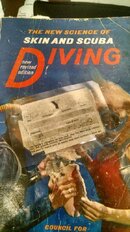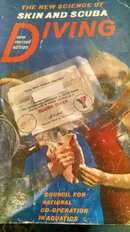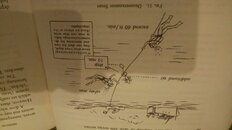Uh...I still have the card. And the book. Go find The New Science of Skin and Scuba Diving and take a look. The third revision, the one I have, is copyright 1968, printed by Association Press in NYC. I was certified in 1972, so that book was current. Let's take the things I mentioned in order:
Deco was on pp. 63-66 (with a 60FPM ascent rate then recommended) and we were taught to use the referenced USN tables in class for both non-deco and decompression planning.
He-Oxygen mixes on pp. 72-73, and 77-78 (but no specific guidance on NDL or deco for mixed gas other than to note that there was more risk, more planning was needed, and to use the tables then current in the USN Diving Manual...dated 1958 at the time). Interestingly to me, while checking my memory, I found that some theory is also presented about N-O2 mixes (nitrox!) with both longer NDLs based on lower PPN2 and the increased risk of O2 toxicity also discussed on p. 77 in proportion to the mix used. It was "under intensive study."
2 ATA max PP02 is on p. 80 and elsewhere. OK, that's 297' and not 300', so I rounded up.
There's other fun stuff in there, too, like an O2 exposure table based on depth and time with a max O2 depth of 40' (for 10 minutes). Somewhere, I seem to recall gas planning (assuming a SAC rate of 1CFM) and carrying more gas if needed, but I didn't go find those. Plenty has changed.
Mixing being confined mostly to Navy and commercial divers, and the prevalent tanks being LP72s, there were no in-water exercises for mixed-gas or deco diving (but staging more gas on the downline is illustrated on p. 66--with the picture showing a safety diver...and a tank with a double-hose regulator!).
At that time, there were NO other levels of certification. It was binary. You were certified, or not, and that's all anyone would usually ask. It was a license to get into as much trouble as you wished. You were expected to figure things out and use reasonable sense. Information was sketchy in many ways.
So what I meant, if it wasn't clear above, was that to get back to the level where people would accept the highest card I held for anything I wanted to get that was available to certified divers, and to dive within the same limits I was originally taught (some of which are insane by today's standards), I needed AOW, extended range, deco procedures, nitrox and advanced nitrox, and normoxic trimix on top of my original OW cert. Did I learn a lot more on the way? Is doing it the new ways, not to mention with modern gear, a lot safer? Of course! But I was not trying to argue otherwise. I put "get back" in quotes for a reason.
Anyway, if the SDI course is anything like the PADI course, "ADVANCED SCUBA DIVER" does seem like it has the potential to mislead.






